Book Review: Coyote Run, by Lilith Saintcrow

Coyote Run is a standalone work. However, Saintcrow’s website calls it “the first Amazing Tale of Antifascist Action,” so I am hopeful that more stories will follow in this setting, especially if this novella does well, which it certainly deserves!
Book Review: CASUAL, by Koji A. Dae

Dae does a great job of writing in Valya’s voice (first person, past tense) so that it’s easy to sympathize with the protagonist, without necessarily agreeing with her choices. She clearly cares deeply for “baby-girl” and is trying hard to make good plans and be a good mother-to-be; however, she’s had a hard life…
Liberty’s Daughter and Thoughts on Worker Bees

Content Warnings: Plot spoilers (after a further warning) for Liberty’s Daughter by Naomi Kritzer and A Deepness in the Sky by Vernor Vinge, and exploitation discussion. Continuing my 2024 Hugo Awards Finalists reading, I gobbled up Liberty’s Daughter by Naomi Kritzer in one sitting. This was my first book in the Lodestar Award for Best Young Adult Book category, so I can’t rank it yet, but I certainly found it age-appropriate, entertaining, and thought-provoking. Some of those thoughts relate to other books, and some relate to current topics. In Liberty’s Daughter, Beck Garrison lives a fairly privileged life on a “seastead” where people have connected floating platforms and actual ships to form a network of communities independent of normal, landlocked countries. All of them are fairly libertarian, and one site recognizes no laws at all. That hasn’t been a problem for Beck before the beginning of this book, because she’s the daughter of an important man. However, when she starts helping a debt slave to track down a missing sister, she stumbles into trouble. With the help of a friend and various other people, she exposes some horrible things that have been happening out of public view. Her moral stands not only have strongly negative personal consequences, at least in the short term, but roil her entire society. I like Beck a lot more than some YA protagonists I’ve encountered. Her father calls her stubborn and selfish, but really, she’s smart, active, persistent, and brave. She’s naive at first, but knows a lot about how her society works, on the surface at least, and how to persuade people to do things and cooperate with each other. She can be too impulsive for her own safety, but partly that’s because she believes in doing what’s right and helping other people. Some people may think that things work out a little too easily for her, but to me, it’s not too surprising that her natural leadership, abilities to figure things out and get things done, and good heart are recognized by others. And anyway, things don’t go her way all the time. Liking Beck is a large part of why I like this book, but I also like how social issues are explored. I’d mentioned a debt slave. Most of the grunt labor in this collective is done by “bond workers” who are sort of a combination of indentured servants and company-store workers, usually going gradually deeper in debt rather than working their way out, and health issues can make that decline a lot sharper and faster. Revelations about what happened to the missing sister, who’s a bond worker herself, lead to some collective actions. MAJOR SPOILERS FOLLOW! Beck helps to avert a violent reaction from the bosses, but just as things seem to be calming down, a wave of sickness with symptoms of obsessive behavior sweeps over the seastead. Eventually, Beck and her allies discover that the epidemic is an engineered virus that got out of control – a virus that was supposed to turn discontented bond slaves into happy workers. But the so-called “worker-bee” virus works TOO well in this respect, even from the view of the bosses; as it brings unanticipated side effects, the ensuing societal breakdown leads to more illnesses and other problems. This reminded me strongly of the Focused workers in A Deepness in the Sky, by Vernor Vinge. That’s a really great book where a whole lot is going on, but the relevant bit is that one faction uses a technology-activated virus to attack enemies or turn some of their own people into brilliant super-specialists who only care about their projects, so they can make even more scientific advances (and are thus highly unlikely to examine society and their place in it). Some workers manage to realize this and think past their induced condition, and even to start thinking about rebellion, but usually they get caught and are reset to “happy” worker-bee status by an MRI-like procedure. The streaming series Severance (2022) approaches this from a slightly different angle. I haven’t watched it, since I don’t have Apple TV+, but I understand that workers at a fictional company agree to a procedure that severs their work memories and personal memories, which supposedly helps them concentrate more efficiently at work. Naturally, this leads to exploitation. The show won critical acclaim and a lot of buzz, and a second season is planned. When I was seeing ads for that show, I was reminded of a horrific series of advertisements some years ago where people had TVs/computer monitors instead of heads (like Prince Robot’s people in Saga), so you could see that even when they were off work, going about their daily lives, playing tennis or whatever, they were still thinking about work. This was supposed to show how dedicated the company’s employees were to serving the viewers, the implied customers, but to me and some friends, it exemplified expectations of depersonalization and exploitation of workers. It seems that a growing number of science fiction creatives are thinking about this trend. In the past, fears have been expressed of work-focused robots replacing humans (or human worker classes being bred and later genetically designed, from Aldous Huxley’s Brave New World to C.J. Cherryh’s Cyteen and beyond); more recently, the trend in fiction has been of taking humans themselves and just cutting out the parts that don’t directly serve capitalism, making individual lives far less rich and rewarding, and damaging the creativity, diverse thinking, and even the problem-solving skills of all humanity. These days, of course, that implied desirability of always concentrating on work is far closer to reality. Even without worker-bee drugs or Focused/Severance-type modifications, increasing numbers of jobs include the expectation that employees will be available 24/7 by text and email, and on-call for just-in-time scheduling even for ordinary, non-emergency shift work. Other societal trends are also keep people’s minds mostly on work and away from volunteerism (numbers are way down) and activism. Whether that’s more or less
Book Review: Archangels of Funk, by Andrea Hairston

I loved Redwood and Wildfire when I found it in the New Books section of the library a few years ago, so I was excited to have the opportunity to read a new book set in that world, Archangels of Funk, which was published on May 7. This is a fantastic near-future book that combines magic and hopepunk with vibrant, joyful optimism, where a diverse community works together to survive and thrive as an independent cooperative amid an increasingly corpocratic world. Redwood and Wildfire was set in the American South of the 1890s, with magic, and told how Black teen Redwood Phipps and her eventual love, Aidan Wildfire Cooper, moved through time and became part of the early days of the film industry. Somehow I had missed the middle book in the series, Will Do Magic for Small Change, about their granddaughter, Cinnamon Jones, but I’m happy to say that I didn’t have any problem moving from the first book to the third; I’m sure to have missed some nuances and callbacks, but I didn’t experience any puzzlement or feel that there were any missing pieces. In fact, I’d say that a new reader could probably start with this book (although Redwood and Wildfire, at least, is great and worth finding); there are certainly references to the characters and events of Redwood and Wildfire, but they are explained well enough that there isn’t any significant missing context. Archangels of Funk is told (in third person past tense) following several points of view, including a Border Collie, another dog who’s a cyberghost, some Circus-Bots, and a friend, but the main protagonist is Cinnamon Jones. She’s a tech wizard who’s a leader in her community of farmers and Water Wars refugees but who tries to avoid being noticed by the wider world. An older woman, she’s had her share of past glories and heartbreaks. Her focus now is on helping others while honoring her ancestors and the spirits of her heritage; she doesn’t think she can change the world, but she fights to keep her corner of it viable and unique. There is a LOT going on in this book. It starts two days before the community’s annual Next World Festival, which Cinnamon runs, as she searches for one of her missing Circus-Bots. These are theatrical junk-sculptures that she had built and animated with computer code and hidden hoodoo. She finds a Circus-Bot sheltering a little girl who’d fled from child-snatchers. The Festival is an ongoing tight-time focus throughout most of the book, but there are also echoes from Cinnamon’s past that come to confront her, including former lovers and betrayers, and people who try to lure her to sell her secrets and sell out. Other subplots include various theft/con attempts, a couple of security guards who are basically just trying to get by at the start, but whom Cinnamon and the community try to influence to actually do good and be good people, an ancestral spirit who helps Cinnamon and the community but who is fading, and several budding or recurring romances. Redwood and Wildfire is bright and dark and jangly and eventually soothing. It’s a hard world, but when has it not been? It can be overwhelming, but Hairston passionately demonstrates in her writing that community ties of love and hope, and occasionally offering second chances to people, can make hearts soar. There are oppressive systems and a lot of exploitative individuals, but it is very much worth continuing to fight for a better world in small ways that add up to big things. I adore this book and the people in it. This is one of my favorite books so far this year. Please give it a try. Content Warnings: Deaths, threats, betrayals Disclaimer: I received a free review copy of this ebook from the publisher.
Book Review: Jumpnauts by Hao Jingfang (translation by Ken Liu)

Jumpnauts, in the end, is a very ambitious and interesting novel.
Book Review: State Tectonics by Malka Older

State Tectonics concludes Malka Older’s Centenal Cycle trilogy, bringing to a head the tensions and potentials for change that have been laid in Infomocracy and continued through Null States. By the end of the second volume of the Centenal Cycle, Null States, the threats to the 21st century political and social order, the dominance of 100,000 person micro democracies, the centenals, has been laid bare and made clear. Sure, the remaining legacy nations have their problems with the dominant Centenal system and might, like China, seek to subvert it and change it for its own ends. Other more militaristic nations might overwhelm nearby Centenals. But the greatest threat to the Centenal system is a hitherto unknown one—one from inside Information itself.

